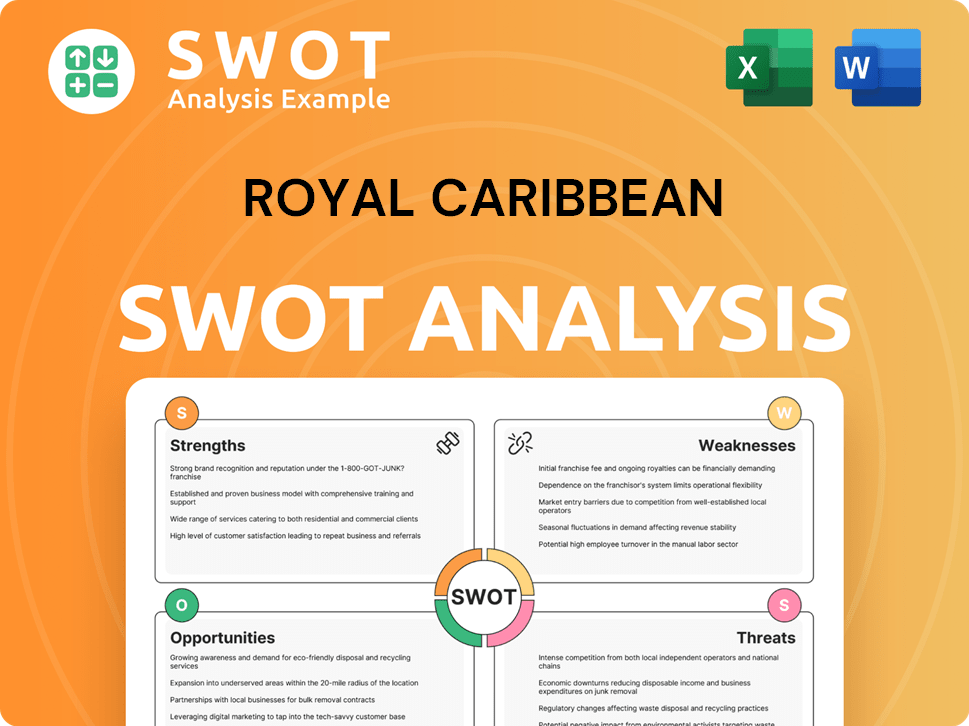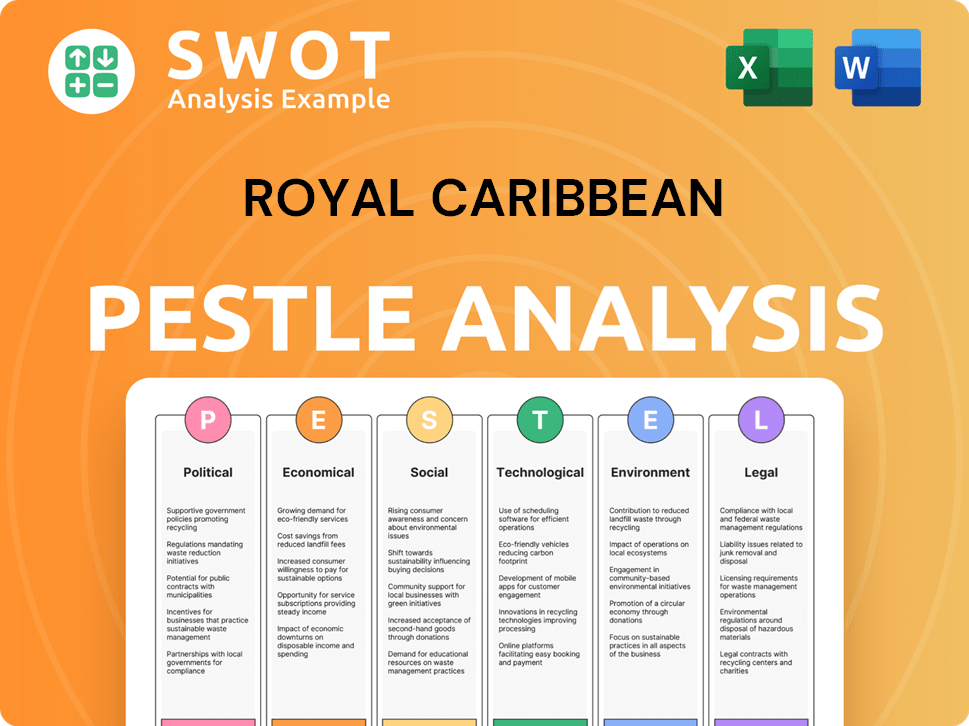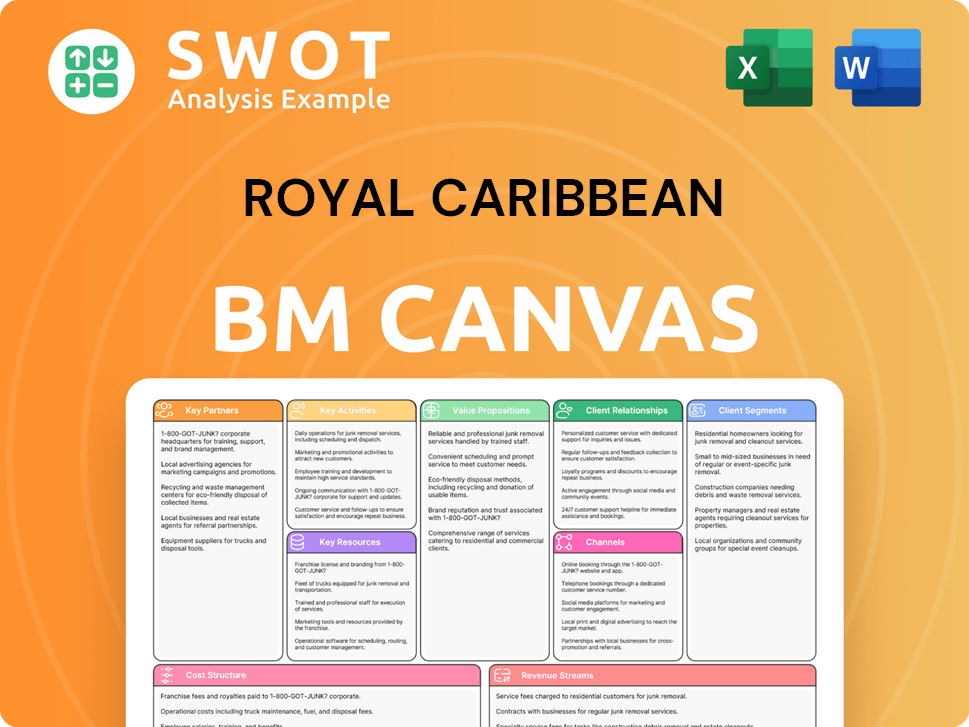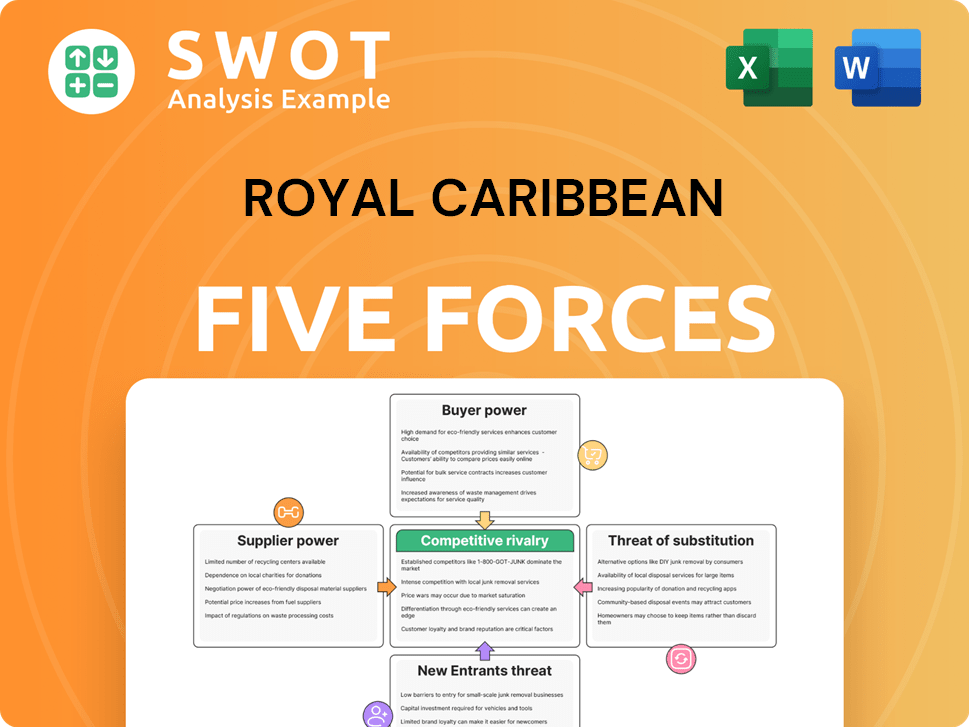Royal Caribbean Bundle
How Does Royal Caribbean Conquer the Waves of the Travel Market?
Royal Caribbean's journey from a traditional cruise line to a global leader is a masterclass in strategic adaptation. Launched in 2015, the "Come Seek" campaign redefined its brand, shifting from relaxation to adventure, attracting a new wave of travelers. This strategic pivot highlights the evolution of their Royal Caribbean SWOT Analysis and its dynamic sales and marketing strategy.

This exploration delves into Royal Caribbean's effective sales strategy, examining its innovative marketing plan, and brand positioning within the competitive cruise line marketing landscape. We'll uncover how Royal Caribbean's digital marketing strategy, social media marketing, and customer relationship management contribute to its success. Furthermore, we'll analyze their pricing strategy for cruises, sales promotions and offers, and the impact of their marketing campaigns, providing insights into their market segmentation strategy and advertising strategies.
How Does Royal Caribbean Reach Its Customers?
The sales channels employed by Royal Caribbean are designed to reach a broad customer base, utilizing a blend of online and offline methods. A core component of their strategy involves direct bookings through their website, providing detailed information and booking capabilities. They also heavily rely on travel advisors and agencies, which have historically been a key channel for the cruise industry, offering personalized service and expert advice.
Digital adoption is a significant focus, with investments in optimizing the online booking experience and integrating omnichannel strategies. While physical retail locations are not a primary channel, the company maintains a presence at travel shows for direct engagement. Strategic partnerships with online travel agencies (OTAs) and tour operators further expand their reach. For example, in 2024, digital bookings continued to show strong growth, reflecting the company's successful transition towards more online-centric sales strategies.
The Competitors Landscape of Royal Caribbean reveals how the company strategically uses various sales channels to maintain its market position. This multi-channel approach ensures accessibility and caters to diverse customer preferences.
The company's website serves as a primary sales channel, offering detailed itineraries, pricing, and booking functionalities. This direct approach allows for control over the customer experience and data collection. Direct online bookings are crucial for driving revenue and understanding customer behavior.
Partnerships with travel advisors and agencies remain a vital sales channel. These professionals provide personalized service and expert recommendations, catering to customers who prefer assistance. This channel is particularly important for complex bookings and building customer loyalty.
Collaborations with OTAs extend the company's reach to a wider audience, particularly those who use these platforms for travel planning. OTAs provide additional visibility and booking convenience. These partnerships contribute significantly to the company's overall sales volume.
The company maintains a presence at consumer travel shows and events to engage directly with potential customers. These events offer opportunities for direct interaction, showcasing cruise options and facilitating bookings. This direct engagement helps build brand awareness and generate leads.
Royal Caribbean's sales strategy focuses on a multi-channel approach, combining direct online bookings, partnerships with travel agents, and collaborations with OTAs. The company has increased its digital focus, with a greater emphasis on optimizing the online booking experience and integrating omnichannel strategies to ensure a seamless customer journey. In 2024, digital bookings showed strong growth, reflecting the success of their online-centric sales strategies.
- Direct Bookings: The company's website offers detailed information and booking functionalities.
- Travel Agents: Partnerships with travel agents provide personalized service.
- OTAs: Collaborations with OTAs expand reach and booking convenience.
- Digital Focus: Increased investment in optimizing the online booking experience.
Royal Caribbean SWOT Analysis
- Complete SWOT Breakdown
- Fully Customizable
- Editable in Excel & Word
- Professional Formatting
- Investor-Ready Format

What Marketing Tactics Does Royal Caribbean Use?
The company employs a multifaceted approach to its marketing endeavors, aiming to boost brand recognition, generate leads, and ultimately, drive sales. This strategy involves a blend of digital and traditional marketing methods, all geared towards reaching a diverse customer base and showcasing the unique experiences offered by their cruises. A key focus is placed on leveraging data to personalize marketing messages and optimize campaign performance.
Digital marketing plays a crucial role in the company's strategy. This includes content marketing, search engine optimization (SEO), paid advertising, email campaigns, and influencer partnerships. These tactics are designed to engage potential customers and provide them with the information they need to make informed decisions. The company also utilizes social media platforms and traditional advertising channels to broaden its reach and maintain a strong brand presence.
The company's marketing strategy is continually evolving to adapt to changing consumer behaviors and technological advancements. They are investing in innovative technologies, such as virtual reality (VR), to enhance the customer experience and provide immersive previews of their offerings. This forward-thinking approach ensures that the company remains competitive in the cruise industry.
The company utilizes content marketing through engaging blog posts, videos, and destination guides. These resources are designed to inspire travel and educate potential cruisers. This approach helps to build brand awareness and establish the company as a trusted source of information.
SEO efforts are crucial for ensuring high visibility in search results for relevant cruise-related queries. This helps potential customers find the company's website and learn more about its offerings. Effective SEO can significantly increase organic traffic and lead generation.
Paid advertising, including search engine marketing (SEM) and display ads, strategically targets potential customers. Advertisements are placed across various platforms based on interests and demographics. This allows for precise targeting and efficient use of marketing budgets.
Email marketing campaigns are vital for nurturing leads and retaining existing customers. Personalized promotions and updates are offered to subscribers. This helps to build customer loyalty and drive repeat bookings.
Partnerships with travel bloggers and social media personalities are increasingly prominent. Authentic endorsements help reach wider audiences and build credibility. Influencers create engaging content that showcases the cruise experience.
Platforms like Instagram, Facebook, and TikTok are actively used for engaging content and promotional campaigns. Social media is also used for customer service. This helps to build a strong online community and drive engagement.
The company continues to use TV commercials, radio advertisements, and print media in key markets. This ensures broad brand awareness, especially in regions where digital penetration may be lower. The company's approach to data-driven marketing is evident in its sophisticated customer segmentation strategies, allowing for highly personalized messaging and offers. The company employs advanced analytics tools to track campaign performance, optimize spending, and understand customer behavior. Brief History of Royal Caribbean provides more insights into the company's evolution.
- Customer Segmentation: The company segments its customer base to tailor marketing messages and offers. This ensures that the right message reaches the right audience, increasing the likelihood of conversion.
- Campaign Performance Tracking: Advanced analytics tools are used to monitor campaign performance. This allows for real-time optimization and adjustments to maximize ROI.
- Virtual Reality (VR) Experiences: The company uses VR to showcase ship amenities and destinations. This provides immersive previews to potential guests, enhancing their booking experience.
- Loyalty Programs: The company has loyalty programs designed to retain customers and encourage repeat bookings. These programs offer exclusive benefits and rewards.
- Pricing Strategy: The company employs dynamic pricing strategies to optimize revenue. Prices are adjusted based on demand, seasonality, and other factors.
Royal Caribbean PESTLE Analysis
- Covers All 6 PESTLE Categories
- No Research Needed – Save Hours of Work
- Built by Experts, Trusted by Consultants
- Instant Download, Ready to Use
- 100% Editable, Fully Customizable

How Is Royal Caribbean Positioned in the Market?
The brand positioning of Royal Caribbean is carefully designed to establish itself as a leader in the cruise industry, especially for those seeking active and adventurous vacations. Its core message, 'Come Seek the Royal Caribbean,' highlights exploration, exciting activities, and memorable experiences at sea and in port. The visual identity often showcases dynamic images of its ships, vibrant destinations, and guests participating in thrilling activities.
The company's tone is energetic, aspirational, and inviting, encouraging guests to step outside their comfort zones. The customer experience focuses on unparalleled entertainment, diverse dining options, and innovative onboard amenities that cater to a wide range of ages and interests. Royal Caribbean differentiates itself through innovation, introducing groundbreaking ship designs and onboard features, and offering a diverse range of itineraries. This approach positions it as a premium yet accessible option in the cruise market.
Royal Caribbean maintains brand consistency across all channels, from its website and social media to onboard signage and crew interactions. The company constantly monitors consumer sentiment and competitive threats, adapting its messaging and offerings to stay relevant. Recent data indicates a strong association with family-friendly adventure and cutting-edge ship technology.
The brand identity emphasizes adventure and innovation, appealing to a broad audience. The visual elements, including ship designs and destination imagery, are consistently used across all platforms. The company's messaging is designed to inspire a sense of excitement and discovery, encouraging potential customers to book cruises.
Royal Caribbean targets families, couples, and adventure seekers. The marketing efforts are tailored to showcase the diverse range of activities and experiences available on its ships. The Royal Caribbean sales strategy focuses on reaching specific customer segments through targeted advertising and promotions.
Royal Caribbean differentiates itself through its innovative ship designs and onboard amenities. The company constantly introduces new features and activities to stay ahead of its competitors. The focus on unique experiences helps it stand out in the competitive cruise market.
Royal Caribbean maintains brand consistency across all its marketing channels. The company actively monitors consumer feedback and competitive trends. This allows it to adapt its messaging and offerings to remain relevant and compelling.
Royal Caribbean's brand is built around several key attributes that resonate with its target audience. These attributes are consistently communicated across all marketing materials and customer interactions.
- Innovation: Continuous introduction of new ship designs and onboard features.
- Adventure: Emphasis on exciting activities and destinations.
- Family-Friendly: Catering to a wide range of ages and interests.
- Entertainment: Offering diverse entertainment options and experiences.
- Premium Experience: Providing high-quality service and amenities.
Royal Caribbean Business Model Canvas
- Complete 9-Block Business Model Canvas
- Effortlessly Communicate Your Business Strategy
- Investor-Ready BMC Format
- 100% Editable and Customizable
- Clear and Structured Layout

What Are Royal Caribbean’s Most Notable Campaigns?
The sales and marketing strategies of the company have been pivotal in shaping its brand and driving growth. Key campaigns have been instrumental in attracting new demographics and enhancing brand perception. These initiatives often leverage innovative approaches to showcase the cruise experience, boosting bookings and maintaining a competitive edge within the cruise line industry.
One of the main goals of the Royal Caribbean sales strategy is to highlight the unique aspects of its offerings. This approach involves creating compelling narratives around onboard activities, exotic destinations, and innovative ship designs to attract a broad audience. The company's focus on digital marketing and social media campaigns underscores its commitment to reaching potential customers through various channels.
The company's marketing plan has consistently adapted to changing consumer preferences and market trends. By focusing on aspirational messaging and tangible product innovation, the cruise line has maintained its position as a leader in the industry. This adaptive approach allows the company to effectively communicate its value proposition and generate substantial commercial success.
This campaign aimed to redefine cruising, attracting a younger demographic through high-energy commercials. The focus was on showcasing active and adventurous vacation experiences. It significantly boosted brand engagement and increased bookings.
This campaign generated immense buzz and pre-bookings for the Icon of the Seas. Extensive digital marketing, social media teasers, and influencer partnerships were used. The campaign resulted in record-breaking booking days and high anticipation.
Collaborations with celebrities like Lionel Messi as the 'Icon of Icon' for the Icon of the Seas. These partnerships boosted brand visibility and credibility among new audiences. These strategic alliances enhance the brand's appeal.
The company's digital marketing strategy includes targeted advertising on social media platforms. They utilize data analytics to personalize marketing messages and improve conversion rates. These efforts are crucial for reaching a wide audience.
The company conducts thorough market segmentation to understand its target audience. They tailor their marketing efforts to different demographics and psychographics. This helps in creating more effective and personalized campaigns.
The company actively uses social media platforms to engage with potential customers. They share engaging content, run contests, and interact with followers. This increases brand awareness and drives bookings.
The company uses a dynamic pricing strategy to maximize revenue. They offer various promotions and discounts to attract customers. These offers are often time-sensitive to encourage bookings.
The company focuses on building strong customer relationships through loyalty programs. They use CRM systems to personalize communication and improve customer satisfaction. This helps in retaining customers.
The company implements various sales promotions to boost bookings. These include early bird discounts, package deals, and limited-time offers. These promotions are designed to drive immediate sales.
The company allocates its marketing budget strategically across different channels. They invest heavily in digital marketing, social media, and traditional advertising. This ensures a balanced approach.
Royal Caribbean Porter's Five Forces Analysis
- Covers All 5 Competitive Forces in Detail
- Structured for Consultants, Students, and Founders
- 100% Editable in Microsoft Word & Excel
- Instant Digital Download – Use Immediately
- Compatible with Mac & PC – Fully Unlocked

Related Blogs
- What are Mission Vision & Core Values of Royal Caribbean Company?
- What is Competitive Landscape of Royal Caribbean Company?
- What is Growth Strategy and Future Prospects of Royal Caribbean Company?
- How Does Royal Caribbean Company Work?
- What is Brief History of Royal Caribbean Company?
- Who Owns Royal Caribbean Company?
- What is Customer Demographics and Target Market of Royal Caribbean Company?
Disclaimer
All information, articles, and product details provided on this website are for general informational and educational purposes only. We do not claim any ownership over, nor do we intend to infringe upon, any trademarks, copyrights, logos, brand names, or other intellectual property mentioned or depicted on this site. Such intellectual property remains the property of its respective owners, and any references here are made solely for identification or informational purposes, without implying any affiliation, endorsement, or partnership.
We make no representations or warranties, express or implied, regarding the accuracy, completeness, or suitability of any content or products presented. Nothing on this website should be construed as legal, tax, investment, financial, medical, or other professional advice. In addition, no part of this site—including articles or product references—constitutes a solicitation, recommendation, endorsement, advertisement, or offer to buy or sell any securities, franchises, or other financial instruments, particularly in jurisdictions where such activity would be unlawful.
All content is of a general nature and may not address the specific circumstances of any individual or entity. It is not a substitute for professional advice or services. Any actions you take based on the information provided here are strictly at your own risk. You accept full responsibility for any decisions or outcomes arising from your use of this website and agree to release us from any liability in connection with your use of, or reliance upon, the content or products found herein.